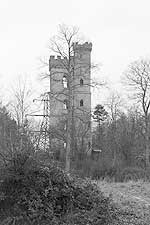
In 1816 the Admiralty carried out trials of a system of semaphore signaling invented by Admiral Sir Home Riggs Popham. The system consisted of a hollow mast bearing two semaphore arms set on or beside a building. These ‘stations’ were in visible distance of each other on an average 6 miles apart, depending on terrain. Messages were passed from one station to another, the letters of the message being represented by the angle of the arms on the mast. Popham was paid £2000 for his system, and, following satisfactory trials, a permanent line was built from London to Portsmouth, whereby a message could be relayed, on a clear day, in an astounding five minutes.
From here the line went via the Hogs Back, to the West of Guildford, to the telegraph at Binsted on River Hill. Built in 1828 - the date was found on a penny buried under the doorstep - it commands a magnificent view over the Surrey and Hampshire countryside. The next link would have been to a bungalow style building at Four Marks, standing some 700 feet above sea level. This building, known today as ‘Semaphore Farm’, carried the line onwards towards Winchester. Although it was envisaged the line would reach Plymouth, by the time the Binsted house was being built, interest was waning, and, as the cost of building the stations was spiraling upwards, the whole project was abandoned in 1831. By this time the line had reached just to the west of Romsey
The house at Binsted had been saved by dereliction by the actions of Binsted Parish Council ensuring that it attained listed status. In 1975 it was converted into a most unusual family home, a project that too more than six years(The photographs on this page were taken as the modernisation was coming to an end). As originally designed it was a simple tower with the two side extensions being added in later years. The operating room, on the first floor, had a 30 foot mast protruding through the roof to carry the semaphore arms. Although the telegraph line was abandoned before completion, test messages were sent between those stations that had been completed. Today, in the 21st Century, it is difficult to imagine such a method of passing messages when, with a pocket sized mobile phone, you can speak to anywhere in the world. |



